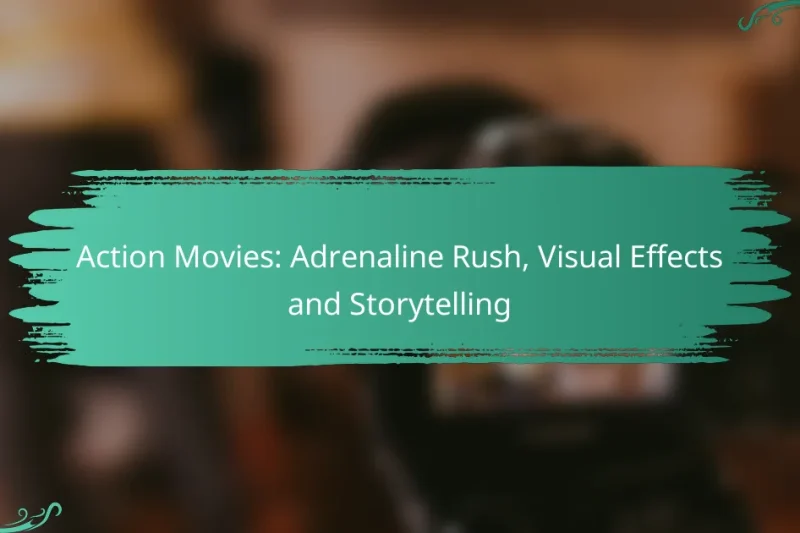Animated films offer a delightful blend of entertainment and valuable life lessons, making them ideal for … Animated Films: Family Fun, Age Appropriateness and EngagementRead more
Movie Genres and Experiences
Movie genres play a crucial role in shaping the cinematic experience, offering audiences a variety of storytelling styles and emotional tones. From action-packed thrillers to heartfelt dramas, each genre sets specific expectations that influence how viewers engage with films. By understanding the unique characteristics of different genres, you can enhance your viewing experience and select movies that resonate with your personal tastes.
Documentaries: Theatrical Impact and Streaming Convenience
Documentaries play a crucial role in enhancing the theatrical experience by delivering immersive storytelling that fosters … Documentaries: Theatrical Impact and Streaming ConvenienceRead more
Sci-Fi Movies: Immersive Worlds, Themes and Fan Engagement
Sci-fi movies are renowned for their ability to immerse viewers in captivating worlds that blend stunning … Sci-Fi Movies: Immersive Worlds, Themes and Fan EngagementRead more
Action Movies: Adrenaline Rush, Visual Effects and Storytelling
Action movies are designed to deliver an adrenaline rush through a combination of high-octane sequences and … Action Movies: Adrenaline Rush, Visual Effects and StorytellingRead more
Horror Movies: Theatrical Thrills and Home Comforts
Horror movies deliver unique thrills whether experienced in a theater or at home. The immersive atmosphere … Horror Movies: Theatrical Thrills and Home ComfortsRead more
What are the most popular movie genres in the United States?
The most popular movie genres in the United States include action, comedy, drama, horror, and science fiction. These genres attract large audiences and often dominate box office sales, reflecting diverse viewer preferences and cultural trends.
Action
Action films are characterized by high-energy sequences, including fight scenes, car chases, and explosive stunts. They often feature a clear protagonist facing off against antagonists, with a focus on physical feats and adrenaline-pumping moments.
Popular examples include franchises like “Fast & Furious” and “Mission: Impossible.” These films typically perform well at the box office, appealing to audiences seeking excitement and thrill.
Comedy
Comedy films aim to entertain and provoke laughter through humor, often using exaggerated situations and witty dialogue. They can range from romantic comedies to slapstick humor, catering to various tastes.
Notable examples include “Superbad” and “Bridesmaids.” Comedies often succeed in attracting diverse audiences, making them a staple in cinema for family outings and social gatherings.
Drama
Drama films focus on character development and emotional narratives, often exploring complex themes such as love, loss, and conflict. These films prioritize storytelling and character arcs over action or humor.
Examples like “The Shawshank Redemption” and “Moonlight” showcase powerful performances and thought-provoking plots. Dramas tend to resonate deeply with audiences, often leading to critical acclaim and awards recognition.
Horror
Horror films are designed to elicit fear and suspense, often featuring supernatural elements, psychological thrills, or slasher themes. They engage viewers through tension-building techniques and unexpected plot twists.
Popular titles like “Get Out” and “The Conjuring” exemplify the genre’s ability to captivate audiences. Horror films often perform well during specific seasons, particularly around Halloween, attracting fans of the macabre.
Science Fiction
Science fiction films explore futuristic concepts, advanced technology, and extraterrestrial life, often raising questions about humanity’s future. They blend imaginative storytelling with scientific possibilities, appealing to both thrill-seekers and thinkers.
Films like “Inception” and “Star Wars” have left significant cultural impacts and often attract large fanbases. Sci-fi movies frequently incorporate special effects and innovative visuals, enhancing the viewing experience and drawing in diverse audiences.
How do movie genres influence viewer experiences?
Movie genres significantly shape viewer experiences by setting expectations for storytelling, emotional tone, and thematic elements. Each genre creates a framework that guides audience reactions and interpretations, influencing how they engage with the film.
Emotional engagement
Different genres evoke distinct emotional responses. For instance, horror films aim to instill fear and suspense, while romantic comedies focus on joy and laughter. Understanding these emotional triggers can enhance viewer satisfaction and connection to the story.
Filmmakers often use specific techniques, such as music and pacing, to amplify emotional engagement. For example, a suspenseful score in a thriller can heighten tension, making viewers more invested in the outcome.
Audience expectations
Genres create specific expectations about plot structure, character development, and resolution. For example, action films typically feature high-stakes conflicts and fast-paced sequences, while dramas may emphasize character depth and moral dilemmas. These expectations guide viewers in interpreting the narrative.
When filmmakers adhere to or subvert these expectations, it can lead to varied audience reactions. A surprising twist in a predictable genre can either delight or frustrate viewers, depending on how well it aligns with their initial expectations.
Cultural impact
Movie genres reflect and shape cultural values and societal norms. For instance, the rise of superhero films in recent years mirrors a cultural fascination with heroism and justice. Genres can also challenge stereotypes and provoke discussions about important social issues.
Films within certain genres can influence trends and behaviors in society. For example, the popularity of dystopian films may lead to increased public discourse on topics like climate change and governance, prompting viewers to reflect on their own realities.
What are the key characteristics of each movie genre?
Each movie genre has distinct characteristics that define its style, themes, and audience appeal. Understanding these traits can enhance your viewing experience and help you choose films that align with your preferences.
Action: Fast-paced sequences
Action movies are characterized by high-energy sequences, including physical feats, chases, and battles. These films often feature a clear protagonist facing formidable antagonists, with the plot driven by conflict and resolution.
Common elements include explosive stunts, fight choreography, and a fast-paced narrative that keeps viewers on the edge of their seats. Popular examples include franchises like “Die Hard” and “Mad Max.”
Comedy: Humor and satire
Comedy films aim to provoke laughter through humor, satire, and often absurd situations. They can range from light-hearted rom-coms to sharp social critiques, appealing to various tastes.
Key techniques include witty dialogue, exaggerated characters, and comedic timing. Films like “Superbad” and “The Hangover” exemplify the genre’s ability to entertain while often reflecting societal norms.
Drama: Character-driven narratives
Drama films focus on character development and emotional depth, often exploring complex themes such as love, loss, and conflict. The narrative typically revolves around personal struggles and relationships.
These films prioritize storytelling and character arcs over action or humor, with examples including “The Shawshank Redemption” and “A Star is Born.” They often resonate deeply with audiences due to their relatable themes.
Horror: Fear and suspense elements
Horror movies are designed to elicit fear, anxiety, and suspense through unsettling themes and imagery. They often incorporate supernatural elements, psychological tension, or graphic violence to create a chilling atmosphere.
Common techniques include jump scares, eerie soundtracks, and dark cinematography. Films like “The Conjuring” and “Get Out” showcase how horror can explore deeper societal fears while providing thrilling entertainment.
Science Fiction: Futuristic concepts
Science fiction films explore imaginative and futuristic concepts, often involving advanced technology, space exploration, or alternate realities. This genre encourages viewers to ponder the implications of scientific advancements on society and humanity.
Elements like speculative technology, alien life, and dystopian futures are prevalent. Examples include “Blade Runner” and “Interstellar,” which challenge perceptions of reality and human existence.
How to choose the right movie genre for a specific audience?
Selecting the right movie genre for a specific audience involves understanding their tastes, preferences, and the context in which they will watch the film. Consider factors such as age, cultural background, and the occasion to ensure the chosen genre resonates with viewers.
Demographic preferences
Demographic preferences play a crucial role in genre selection. For instance, younger audiences often gravitate towards action, fantasy, or animated films, while older viewers may prefer dramas or classic comedies. Understanding these trends can help tailor movie choices to specific age groups.
Additionally, cultural background influences genre appeal. For example, audiences from different regions may favor local storytelling styles, such as Bollywood musicals in India or K-dramas in South Korea. Recognizing these cultural nuances can enhance the viewing experience.
Occasion-based selection
The occasion for watching a movie significantly impacts genre choice. For casual gatherings, comedies or light-hearted films are often preferred, while romantic films may be ideal for date nights. Tailoring the genre to the event can create a more enjoyable atmosphere.
Consider the time of year as well; during holidays, family-friendly films or festive-themed movies tend to be popular. Aligning the genre with the occasion ensures that the audience is engaged and entertained throughout the viewing experience.




